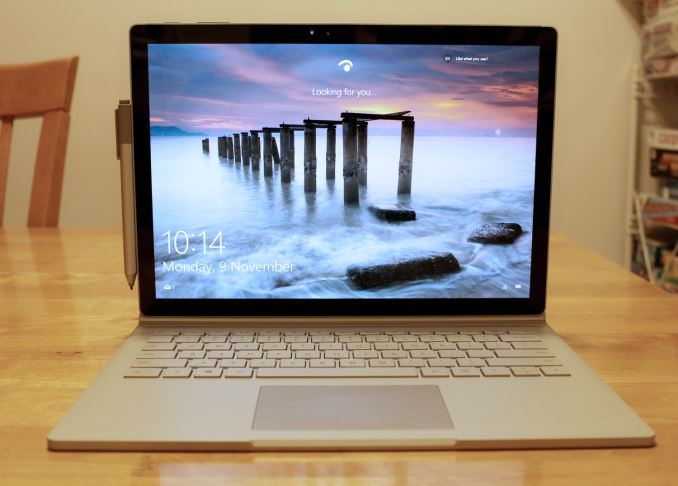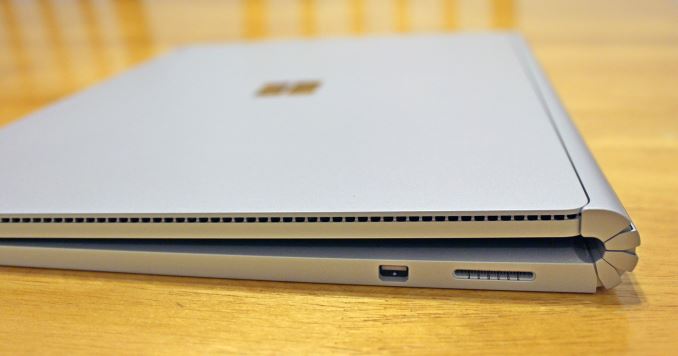The Microsoft Surface Book Review
by Brett Howse on November 10, 2015 8:00 AM EST
When Microsoft first launched the Surface Pro, they decided to tackle a market that was pretty much untested. Sure, tablets had been around for a while already, but no one had packed a full Ultrabook inside of a tablet. True, the initial Surface Pro had some compromises made due to the hardware available at the time, but Microsoft started to build a brand with Surface, a brand that they lifted from another product line altogether. It’s taken a few generations for the hardware to catch up with that original vision, but I think it’s fair to say that the Surface Pro tablet line has solidified itself as the Windows tablet to beat. The build quality, materials, and performance, are really second to none at this time.
I’m talking about branding because it’s one of the most difficult parts of a new product lineup. Microsoft, perhaps more than most companies, has certainly had its struggles with branding over the years. Surface though, has truly been defined, and molded, and evolved, into a strong brand for the company, and it plays right at the high end. And that brings us to Surface Book. Surface Book is an extension of the Surface brand, and Microsoft now wants to try its hands at the laptop market. Their goals for Surface Book are certainly not the same as they were for the original Surface Pro, since the laptop market is already well defined, and there are already many excellent devices available. For Microsoft to throw their hat in the ring in this segment is a much different proposition than before, and to succeed, as well as to continue to evolve the Surface brand, they set out to build what they are calling “The Ultimate Laptop”.
Surface Book certainly keeps the tradition of Surface alive and well. The 13.5-inch laptop has the same 3:2 aspect ratio of the rest of the Surface line, and it is built out of magnesium with the same finish. The fit and finish is very high, and the entire device feels as premium as it should. I think the defining feature of the Surface tablet lineup is the kickstand, and with the Surface Book it is most certainly the hinge. The hinge on the Surface Book is truly unlike anything ever used on a notebook computer before, and while it may not be to everyone’s taste, it certainly draws comments. The hinge, other than a design element, brings a lot of function to the party as well, with it being a key component to keeping this laptop balanced correctly. Balance is generally not an issue with laptops, but the Surface Book has another trick up its sleeve – the display detaches. The Surface Book is hardly the first device to do this, but it is one of the few that has tried to tackle the balance problem with 2-in-1 devices where the screen detaches, and the hinge is a key component to that. Microsoft calls it a Dynamic Fulcrum Hinge, and it extends the base of the laptop slightly to give it more leverage over the display section.
The design is unique, and what is inside is unique as well, at least potentially. There are two models of the Surface Book. The first model is a typical Ultrabook inside, with an Intel Core i5-6300U processor, but the second model is the only detachable laptop which also has a discrete GPU. There are a couple of reasons this has never been done before, with the main reason being it’s very difficult to dissipate the extra heat that a GPU brings to the table. Microsoft has designed the Surface Book with a GPU which lives in the keyboard base, with the rest of the required components behind the display. This gives them two thermal zones, and by moving the GPU to the base like this, it lets the Surface Book cool the CPU and GPU independently. The extra space in the keyboard is then packed with batteries.
| Surface Book | |||
| Core i5 | Core i5 w/GPU | Core i7 w/GPU | |
| GPU | Intel HD 520 | Intel + "NVIDIA GeForce" (Approx. GT 940M) w/1GB GDDR5 |
|
| CPU | 6th Generation Intel Core i5-6300U (15w) | 6th Generation Intel Core i7-6600U (15w) | |
| Memory | 8-16GB RAM | ||
| Display | 13.5" IPS 3000x2000 resolution 1800:1 Contrast Ratio 100% sRGB, individually calibrated 10 point touch and Pen support |
||
| Storage | PCIe 3.0 SSD 128 GB to 1 TB | ||
| I/O | USB 3.0 x 2 (In Base) SD Card reader (In Base) Surface Connector (In Tablet and Base) Headset Jack Mini DisplayPort |
||
| Dimensions | Laptop (mm) : 232 x 312 x 13.0-22.8 (inches) : 9.14 x 12.3 x 0.51-0.90 Tablet Only (mm) : 220.2 x 312.3 x 7.7 (inches) : 8.67 x 12.3 x 0.30 |
||
| Weight | Laptop 1.515 kg / 3.34 lbs Tablet Only 726 g / 1.6 lbs |
Laptop 1.579 kg / 3.48 lbs Tablet Only 726 g / 1.6 lbs |
|
| Camera | Windows Hello (Front) 8 MP Rear Facing 5 MP Front Facing |
||
| Price | $1499+ | $1899+ | $2099+ |
Looking at the specifications, one thing to point out is the battery capacity. Most Ultrabooks would average somewhere around 50 Wh of capacity, with a few somewhat higher and a few somewhat lower. By combining the battery in the tablet, which Microsoft calls the Clipboard, with the base, the Surface Book has an amazing 70 Wh of battery capacity. This should help out on battery life, assuming the 3000x2000 display doesn’t drag that down. The rest of the Surface Book is pretty similar to the Surface Pro 4, with PCIe NVMe storage options up to 1 TB, and touch and pen support via the PixelSense display. There are also two USB 3.0 ports in the base, along with a DisplayPort output, and the Surface Connect port which is used for charging, as well as connecting the Surface Dock. There are no ports on the Clipboard at all, with the exception of the Surface Connect port, so if you are using the Clipboard on its own, you will have to dock it to access USB. Like the Surface Pro 4, it would have been nice to see a USB Type-C port included, and the Clipboard would be a perfect spot for that.
Microsoft is calling the Surface Book “The Ultimate Laptop” and that is a pretty lofty goal for a first generation product. In this review, we will examine all aspects of the Surface Book and see how they compare to the best laptops around. Let’s start with the design.











249 Comments
View All Comments
s.yu - Wednesday, November 11, 2015 - link
Nope, the old VAIO Z using light peak had the same feature.Zan Lynx - Thursday, November 19, 2015 - link
PCIe has been hotplug since Day 1. Now admittedly, OS software and BIOS problems have made that not always work. But for everyone properly following the PCIe specs you should be able to power down the slot and remove a card.id4andrei - Tuesday, November 10, 2015 - link
Loved the review, so honest. Nothing like that exists anymore.I wonder if Chrome's shitty touch optimizations are due to lack of pointer events support. Chrome sucks(relatively) when using the touchscreen as well. I'm getting fed up with Google and its poor Windows support.
Any word of the Surface Pro M3 and Iris i7 down at Anandtech HQ? Will we be seeing some quick comparison points?
Teknobug - Tuesday, November 10, 2015 - link
On my tablets, Edge (uGGGGHHH) works best with touch interaction, Firefox, Chrome and Opera just plain sucks.digiguy - Tuesday, November 10, 2015 - link
There is a review of the M3, which is only around 10% slower than the SP3 i5 (but remember that SP4 i5 is clearly more powerful). What's interesting is that the first benchmarks of Skylake Core M7 (HP Spectre X2) show that it is essentially on par with the Haswell i5 in SP3 (quite great for a fanless device).watzupken - Tuesday, November 10, 2015 - link
Brilliant review. To be honest, this Surface Book got me interested for awhile, however the price is quite off the mark for me. Understandably, this is not meant to compete in the low or mid end. But I still cannot stomach the fact that the hardware is actually quite mediocre in performance but cost a bomb.vLsL2VnDmWjoTByaVLxb - Tuesday, November 10, 2015 - link
Anyone considering this for business use should be aware that this device has numerous show-stopping bugs involving:- Docking and undocking (crashes, onscreen keyboard missing, devices now showing up after dock)
- Surface Dock + External displays (not recognized, weird DPI issues, some displays need a "reset,)
- Devices like Bluetooth needing a re-pairing after dock/away/roaming.
- BSOD/hangs/crashes, including display driver crashes, repeatedly getting the same driver prompt.
This device is actually very heavy, it FEELS heavier than what it's listed at, for some reason. The tablet portion alone feels too heavy to get serious use out of it as a tablet.
We're waiting for the next round of Microsoft patches this week before deciding on whether to return it. Right now it's not release-worthy, and I feel like we should have held off. Amazing. Microsoft is a software company and they have complete control over hardware and software, this shouldn't have been released like this.
MutualCore - Tuesday, November 10, 2015 - link
That's funny. Paul Thurott and others have said that the Clipboard section feels ridiculously light.nerd1 - Tuesday, November 10, 2015 - link
Are you kidding? The tablet portion is the size of TWO iPad and weighs less than iPad first gen. It feels like you are holding real clipboard rather than core CPU device.nikon133 - Tuesday, November 10, 2015 - link
How about some links.We have been using Surface Pro 3 in our office and many of our customers are, too. With SP3 dock, one or two desktop screens... some use Surface's screen as 3rd display. Since monitors with pass-through DisplayPort are rare in NZ, we use EVGA DisplayPort hub which breaks multi-stream to separate DP ports. We had an odd few problems with some monitors, but on average system works fine. We didn't observe any significant problems with freezing and BSOD - perfectly in line with Lenovo ThinkPad or HP EliteBook machines we and our customers use otherwise.
We use Logitech m557 and Microsoft Arc BT mice, and no we don't need to re-pair them. Didn't try many others (those few that we did try worked fine, too), we settled down on those two from the start.
I'm finding it hard to believe - just on your word, at least - that SB is that bad. It might not be as stable on release as SP3 is today, but even if that is the case... give it a firmware or two updates and it will get there.